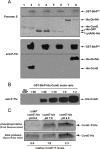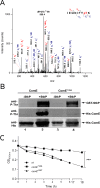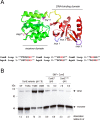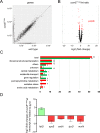Crosstalk between the serine/threonine kinase StkP and the response regulator ComE controls the stress response and intracellular survival of Streptococcus pneumoniae
- PMID: 29883472
- PMCID: PMC6010298
- DOI: 10.1371/journal.ppat.1007118
Crosstalk between the serine/threonine kinase StkP and the response regulator ComE controls the stress response and intracellular survival of Streptococcus pneumoniae
Abstract
Streptococcus pneumoniae is an opportunistic human bacterial pathogen that usually colonizes the upper respiratory tract, but the invasion and survival mechanism in respiratory epithelial cells remains elusive. Previously, we described that acidic stress-induced lysis (ASIL) and intracellular survival are controlled by ComE through a yet unknown activation mechanism under acidic conditions, which is independent of the ComD histidine kinase that activates this response regulator for competence development at pH 7.8. Here, we demonstrate that the serine/threonine kinase StkP is essential for ASIL, and show that StkP phosphorylates ComE at Thr128. Molecular dynamic simulations predicted that Thr128-phosphorylation induces conformational changes on ComE's DNA-binding domain. Using nonphosphorylatable (ComET128A) and phosphomimetic (ComET128E) proteins, we confirmed that Thr128-phosphorylation increased the DNA-binding affinity of ComE. The non-phosphorylated form of ComE interacted more strongly with StkP than the phosphomimetic form at acidic pH, suggesting that pH facilitated crosstalk. To identify the ComE-regulated genes under acidic conditions, a comparative transcriptomic analysis was performed between the comET128A and wt strains, and differential expression of 104 genes involved in different cellular processes was detected, suggesting that the StkP/ComE pathway induced global changes in response to acidic stress. In the comET128A mutant, the repression of spxB and sodA correlated with decreased H2O2 production, whereas the reduced expression of murN correlated with an increased resistance to cell wall antibiotic-induced lysis, compatible with cell wall alterations. In the comET128A mutant, ASIL was blocked and acid tolerance response was higher compared to the wt strain. These phenotypes, accompanied with low H2O2 production, are likely responsible for the increased survival in pneumocytes of the comET128A mutant. We propose that the StkP/ComE pathway controls the stress response, thus affecting the intracellular survival of S. pneumoniae in pneumocytes, one of the first barriers that this pathogen must cross to establish an infection.
Conflict of interest statement
The authors have declared that no competing interests exist.
Figures









Similar articles
-
Eukaryotic-type serine/threonine protein kinase StkP is a global regulator of gene expression in Streptococcus pneumoniae.J Bacteriol. 2007 Jun;189(11):4168-79. doi: 10.1128/JB.01616-06. Epub 2007 Apr 6. J Bacteriol. 2007. PMID: 17416671 Free PMC article.
-
Acidic stress induces autolysis by a CSP-independent ComE pathway in Streptococcus pneumoniae.Microbiology (Reading). 2008 May;154(Pt 5):1300-1308. doi: 10.1099/mic.0.2007/015925-0. Microbiology (Reading). 2008. PMID: 18451038
-
The juxtamembrane domain of StkP is phosphorylated and influences cell division in Streptococcus pneumoniae.mBio. 2025 May 14;16(5):e0379924. doi: 10.1128/mbio.03799-24. Epub 2025 Apr 8. mBio. 2025. PMID: 40197031 Free PMC article.
-
Cell division of Streptococcus pneumoniae: think positive!Curr Opin Microbiol. 2016 Dec;34:18-23. doi: 10.1016/j.mib.2016.07.014. Epub 2016 Aug 4. Curr Opin Microbiol. 2016. PMID: 27497051 Review.
-
The ciaR/ciaH regulatory network of Streptococcus pneumoniae.J Mol Microbiol Biotechnol. 2002 May;4(3):211-6. J Mol Microbiol Biotechnol. 2002. PMID: 11931549 Review.
Cited by
-
A Genome-Wide CRISPR Interference Screen Reveals an StkP-Mediated Connection between Cell Wall Integrity and Competence in Streptococcus salivarius.mSystems. 2022 Dec 20;7(6):e0073522. doi: 10.1128/msystems.00735-22. Epub 2022 Nov 7. mSystems. 2022. PMID: 36342134 Free PMC article.
-
Phosphorylation of GntR reduces Streptococcus suis oxidative stress resistance and virulence by inhibiting NADH oxidase transcription.PLoS Pathog. 2023 Mar 13;19(3):e1011227. doi: 10.1371/journal.ppat.1011227. eCollection 2023 Mar. PLoS Pathog. 2023. PMID: 36913374 Free PMC article.
-
Streptococcus pneumoniae extracellular vesicles aggravate alveolar epithelial barrier disruption via autophagic degradation of OCLN (occludin).Autophagy. 2024 Jul;20(7):1577-1596. doi: 10.1080/15548627.2024.2330043. Epub 2024 Apr 21. Autophagy. 2024. PMID: 38497494 Free PMC article.
-
Dual Role of Hydrogen Peroxide as an Oxidant in Pneumococcal Pneumonia.Antioxid Redox Signal. 2021 Apr 20;34(12):962-978. doi: 10.1089/ars.2019.7964. Epub 2020 Aug 14. Antioxid Redox Signal. 2021. PMID: 32283950 Free PMC article. Review.
-
Structure, Function, and Regulation of LytA: The N-Acetylmuramoyl-l-alanine Amidase Driving the "Suicidal Tendencies" of Streptococcus pneumoniae-A Review.Microorganisms. 2025 Apr 5;13(4):827. doi: 10.3390/microorganisms13040827. Microorganisms. 2025. PMID: 40284663 Free PMC article. Review.
References
-
- Salazar ME, Laub MT (2015) Temporal and evolutionary dynamics of two-component signaling pathways. Curr Opin Microbiol 24: 7–14. doi: 10.1016/j.mib.2014.12.003 - DOI - PMC - PubMed
-
- Claverys JP, Prudhomme M, Martin B (2006) Induction of competence regulons as a general response to stress in gram-positive bacteria. Annu Rev Microbiol 60: 451–475. doi: 10.1146/annurev.micro.60.080805.142139 - DOI - PubMed
-
- Dworkin J (2015) Ser/Thr phosphorylation as a regulatory mechanism in bacteria. Curr Opin Microbiol 24: 47–52. doi: 10.1016/j.mib.2015.01.005 - DOI - PMC - PubMed
-
- Echenique J, Kadioglu A, Romao S, Andrew PW, Trombe MC (2004) Protein serine/threonine kinase StkP positively controls virulence and competence in Streptococcus pneumoniae. Infect Immun 72: 2434–2437. doi: 10.1128/IAI.72.4.2434-2437.2004 - DOI - PMC - PubMed
-
- Pallova P, Hercik K, Saskova L, Novakova L, Branny P (2007) A eukaryotic-type serine/threonine protein kinase StkP of Streptococcus pneumoniae acts as a dimer in vivo. Biochemical and Biophysical Research Communications 355: 526–530. doi: 10.1016/j.bbrc.2007.01.184 - DOI - PubMed
Publication types
MeSH terms
Substances
LinkOut - more resources
Full Text Sources
Other Literature Sources

